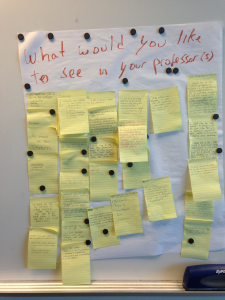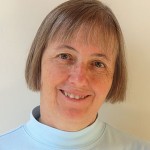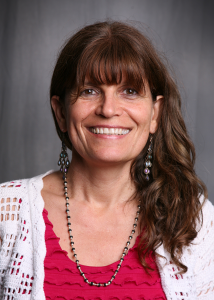How a Salsa-Dancing Former Monk from Argentina Is Instilling Confidence and Wonder in Her Statistics Students
The TANGO principal investigators are Michael Posner of Villanova and Monica Dabos of College of the Canyons, a community college in California.
While discussing the project and much more with Dabos recently, I learned she has some thought-provoking ideas about fostering creativity, collaboration, and personal development in her students as they learn statistics, so I decided to interview her for this column.
To set the stage for my questions, quotes from two of her students follow. Although the first part of each quote is typical of comments received by any stellar statistics instructor, the second part illustrates the personal development Dabos fosters in her students.
—Tanya Hauer
Q: In reading quotes from your students, it’s evident that you are interested in helping them grow as individuals as well as becoming better students. Is there something in your background that led to this more holistic approach to teaching?
This is a long story, but one of the aspects I think affects my teaching the most is my prior experience as a renounced monk focusing on inner transformation and meditation. I travelled to India several times, lived in temples, and practiced several types of meditation for more than eight hours every day for 15 years. The experience showed me the value of meditation and introspection and gave me the desire to do service to the community and society at large.
I believe I understand my students, and that this empathy is recognized right away; the students’ appreciation is reflected in their commitment to excel.
I studied education because of my love for teaching. While I started school with English as a second language at the age of 32, I have earned five degrees, culminating with a PhD in education that focuses on the teaching and learning of statistics. While in school, I went through several hardships that did not stop me from succeeding, but they were certainly blocks. As such, I tend to relate to students’ struggles.
Dancing was always part of my life—before, during, and after life in the temple—but it was not until I moved to Santa Barbara, California, that I found an affinity with ballroom dancing, in particular salsa. I was compelled to do something for the community, especially the young people. I saw around me that the only way young people were enjoying dance was in alcohol-fueled environments, and there was nowhere for those under 21 to enjoy dancing. Committed to making a difference, I started an alcohol-free salsa-dancing community in Santa Barbara that has grown to more than 500 members within three years of opening, and it continues growing with a diverse dance community for all ages.
Q: You have had an interesting journey! How does that influence your teaching?
I think my biggest contributions to students are my enthusiasm for statistics, the understanding that we are all human, and the benefits of balance in life and in the classroom. I believe I understand my students, and that this empathy is recognized right away; the students’ appreciation is reflected in their commitment to excel. My teaching style stems from a small, yet universal set of guiding principles:
- Desiring to maintain self-balance
- Making room in my life for what I find valuable
- Progressively becoming more introspective in my teaching
- Recognizing when something does not work, and being willing to change
- Recognizing students’ real struggles—economically, emotionally, ethnically, or physically

On the first day of class, Monica Dabos asks her students to fill out yellow sticky notes and post them anonymously on big posterboards. They address six questions, one of which is “What would you like to see in your professor?”
Q: In video interviews I saw with your students, they clearly felt a camaraderie with each other. Can you explain what you do to get students comfortable participating in the class?
Student bonding and group work: On the first day of class, students are asked to fill out yellow sticky notes and post them (anonymously) on big poster boards. They are asked to address the following six questions:
- What would you like to see in your professor(s)?
- What behavior do you expect from your classmates?
- What have I learned about myself as a student?
- What worries me about this class?
- What excites me about this class?
- Other things I want to say
After everyone is finished, the class breaks into groups and they summarize what their classmates had to say. Here is one student’s reflection on this activity:
We continue to have group activities throughout the semester, but we change groups every day in class (at random) and have “get to know your classmate” time.
Here is an anecdote that illustrates how close the students come to be and how it benefits them. The mother of one of my students died in his arms during the semester. He missed two weeks of class when we were learning hypothesis testing, plus students started to work on final projects. He came back on a review day for an exam. We stopped the class to greet him with hugs and tears; it was a sad day for all of us, but then we got to work. All the students told him that they would help him with the material he had missed and met with him for several hours after class. He took the final exam and took part in the final project and presentation. He got an A on the final exam.
TED Talks: I assign a TED Talk every two weeks during class time or for homework or both. After watching a TED Talk for 18 minutes and reflecting on it for 10 minutes, a half-hour of valuable class time is used, but the next two hours of lessons are so focused and engaged that we cover a lot of material with much greater depth, participation, and appreciation. Here is an example of student feedback on the TED Talks:
We also watch TED Talks like “How Not to Be Ignorant of the World” and “Why Smart Statistics Are the Key to Fighting Crime.” I make sure that my students are inspired by something big, and then they can do something small in the class like a poster presentation related to cereal and shelf placements.
Fun, real, hands-on activities: Especially in the beginning, we do activities in class that are related to their lives and that are fun. In one such activity, we discuss whether men or women text faster on their phone. Then students have to find a way to measure this. They have to brainstorm in groups all the possible variables that may affect the result of the text speed. They categorize each variable as numerical or categorical, and they then decide whether we can control some of those variables and we conduct a classroom experiment. We talk about if the results would be true for all men or women. That is normally a fun and applicable activity early on in the semester. They are used to teachers saying “No phone in class!” So I say, “Take your phones out; let’s do an experiment.”
Q: I know you are a strong supporter of the ASA’s Guidelines for Assessment and Instruction in Statistics Education (GAISE). How do you think teaching according to the GAISE guidelines has changed the students’ experience of taking a statistics class, and/or their view of statistics?
Making it real, more applicable, fewer computations. More hands-on experiences help students connect with statistics and think critically about what they are doing. When students know it is real, they see the value, the applicability, and they want to do it. I remember once I asked my students to correct a survey that was used by one of the departments at Santa Barbara City College for collecting data. I told them to comment on what changes the survey needed for improvement and why. Students worked in groups. I told them this was for real, that this survey is used for the GATEWAY program, and they will take their comments seriously as they would like to improve their survey. Students were on it like a mission; they took it so seriously—real application has great appeal to them.
Q: The TANGO Stat Ed project helps connect community college teachers with university professors and seems to be a success. Do you have any recommendations for college professors who might want to interact with community college teachers, or vice versa?
The most important themes across my teaching, my community involvement, and my research projects like TANGO are that people work better when they are not in isolation, when they are not afraid to ask questions, and when they feel free to express themselves because they know their voice counts. No one likes to feel minimized for not understanding or knowing, but when the right environment is created, everyone appreciates the opportunity to help one another grow and concepts of collaboration and respect become tangible results.












 (2 votes, average: 4.50 out of 5)
(2 votes, average: 4.50 out of 5)







Great article! I am going to try some of Monica’s activities she shared in the article. Thank you!
Beth